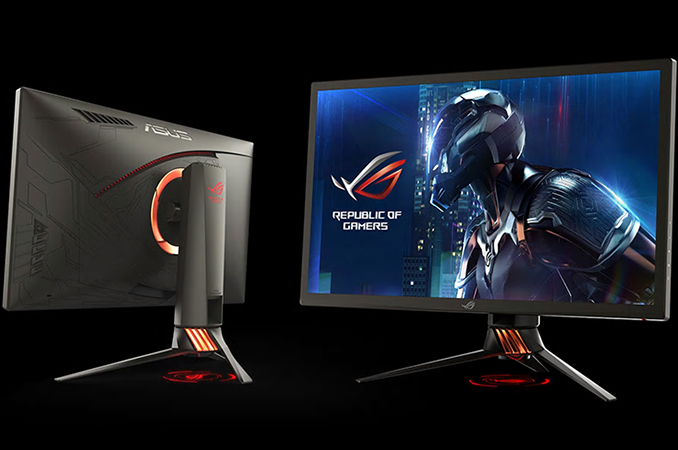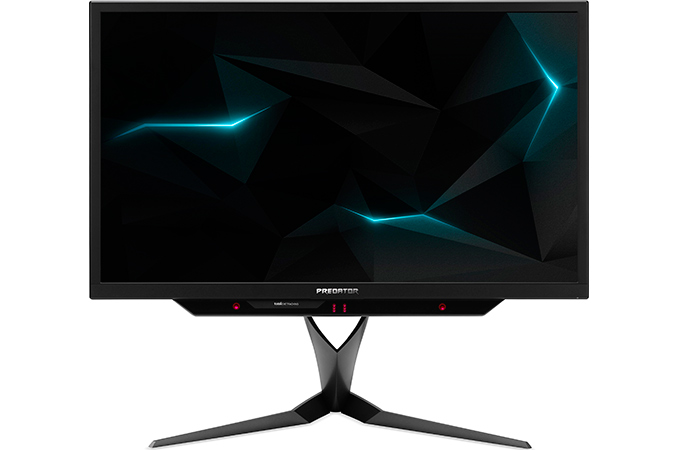NVIDIA Expects 4K 144 Hz G-Sync HDR Displays to Launch in April
by Anton Shilov on March 21, 2018 6:35 PM EST- Posted in
- Monitors
- Displays
- Acer
- Asus
- NVIDIA
- Predator X27
- ROG Swift PG27UQ
- G-Sync HDR

Acer and ASUS unveiled their prototype 27” 4K 144 Hz displays, featuring NVIDIA’s G-Sync HDR technology, at last year’s CES, with promises to release them sometime later in 2017. Both monitors relied on a reference design developed by NVIDIA and had similar specifications, albeit with some minor differences. Eventually, both companies had to delay commercial launches of their new products to 2018, missing the important holiday sales season. This week at GDC, NVIDIA has stated that it is confident that the G-Sync HDR-compatible displays will hit the market this April.
Both the Acer Predator X27 and the ASUS ROG Swift PG27UQ are implementations of NVIDIA’s reference design for G-Sync HDR displays: they offer a 3840×2160 resolution, a 144 Hz refresh rate, a 1000-nits brightness, a direct LED backlighting system with 384 zones, and feature a quantum dot film to enable HDR10 and coverage of the DCI-P3 color gamut. The monitors announced last year were to be based on AU Optronics’ M270QAN02.2 AHVA panel, which was the only one to support the combination of features that NVIDIA wanted for G-Sync HDR displays.
Neither Acer, nor ASUS, disclosed the reasons why they had to delay their ultra-premium gaming monitors from late 2017 to 2018, but given a rather unique feature-set of both displays, a lot of possibilities come to mind: starting from a panel delay by AUO to reference design changes by NVIDIA.
At GDC, NVIDIA has said that G-Sync HDR-supporting displays will finally ship in Q1, but noted that by Q1 it means its fiscal quarter, not calendar quarter. NVIDIA’s Q1 FY2019 (2019 because NV's fiscal year is one year ahead) ends on April 29, 2018, so it is logical to assume that the monitors will ship next month. What remains to be seen is the pricing as well as the final set of features and technologies.
Related Reading
- Acer and ASUS Delay Their 4K 144 Hz G-Sync HDR Displays to 2018
- ASUS Demonstrates ROG Swift PG27UQ: 4K, 144 Hz, HDR, DCI-P3 and G-Sync
- Acer Announces Predator X27 Monitor: 4K@144 Hz with DCI-P3, HDR10, & G-Sync
- Samsung Announces First Freesync 2 Monitors: CHG70 & CHG90 - Quantum Dots, Up to 49”, 144 Hz, DCI-P3
Source: NVIDIA











61 Comments
View All Comments
TristanSDX - Thursday, March 22, 2018 - link
Monitors with 384 FALD will soon be outdated, as AUO will release monitors with mini-led backlight without irritiating 'halo' issues.https://www.ledinside.com/news/2018/3/auo_to_ship_...
DanNeely - Thursday, March 22, 2018 - link
Assuming AUO doesn't end up slipping the release dates for them by a year because of manufacturing problems again.And ofc, by the time those are out something else even better will be on the horizon...
edzieba - Thursday, March 22, 2018 - link
Companies have been chasing inorganic LED planar arrays for a long, long time. Remember CrystalLED?FreckledTrout - Thursday, March 22, 2018 - link
At least in this case AUO is just shrinking the backlight down so I don't expect much delays. The MicroLED's as Samsung is calling them now for the planar arrays are still a long ways off.Hixbot - Thursday, March 22, 2018 - link
It's frustrating that gsync displays don't also support the new VRR standard. I can understand why freesync/vrr displays don't have gsync as it has a cost. But gsync displays should support vrr as it's free. The separation of the two standards is preventing me from buying a display at all. Are you listening, display manufacturers? I'm not buying a display until it supports gsync and vrr.3DoubleD - Thursday, March 22, 2018 - link
Amen. Super annoying to be locked into one GPU manufacturer because of the monitor. I guess NVIDIA is still making money on GSync, otherwise they would have abandoned it already. I'm also hoping one standard is adopted for TV's as well. While GPU and memory prices are outrageously high, there is nothing but waiting left to do...mooninite - Thursday, March 22, 2018 - link
I bet it's AUO's terrible QA on the panels causing the delay. If they are anything like their 27" 1440p g-sync displays these are bound to be really bad as well.Read reviews for the ASUS PG279Q or Acer/ViewSonic models. They all use the same AUO panel.
willis936 - Thursday, March 22, 2018 - link
Hmm I've had an AU Optronics M270DAN02.3 for two years. No dead pixels and contrast ratio of 1100:1. Not every panel that leaves their factory is bad.Hurr Durr - Friday, March 23, 2018 - link
It's not dead pixels these days, but light bleed and such.willis936 - Saturday, March 24, 2018 - link
Yeah I think I measured 20% uniformity. For the feature list and price I don't expect a perfect product. I'm very happy with it and was glad to get my hands on the first consumer 1440p 120+ Hz IPS. I can't see myself upgrading before OLED is more standard. The contrast ratio and response time is good for any application.